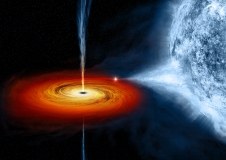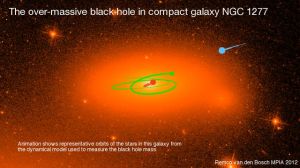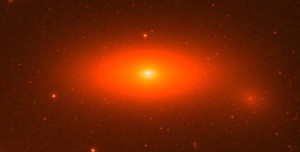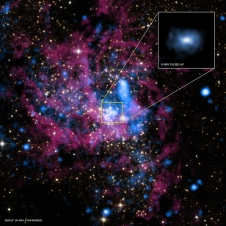
The nature of the beast
Astronomy news (November 26, 2013) – Astronomers believe the size of a black hole should be related to the size of the galaxy in which it resides, so the smaller a galaxy, the less massive its black hole should be. The lenticular galaxy NGC 1277 appears to have a black hole near its center with a mass out of proportion to its size, which indicates this theory will have to be looked at again.

Watch this animation on the possible orbit of the massive black hole in NGC 1277, https://www.youtube.com/watch?v=pFkBKmAj0G4.
NASA astronomers conducting a study of black holes at the Max Planck Institute for Astronomy recently used the Hubble Space Telescope and Hobby-Eberly Telescope in Fort Davis, Texas to measure the velocities of stars in orbit around NGC 1277. The higher the velocity of these stars, the greater the mass of the central object. NGC 1277 is located at a distance of around 250 million light-years, toward the constellation Perseus.

Astronomers measured the mass of the object at the center of NGC 1277 to be around 17 billion times the mass of the Sun, which is over four thousand times more massive than the 4 million solar mass black hole at the center of the Milky Way. Until recently, the two most massive central bodies found in any galaxy measured by astronomers reside in galaxies NGC 3842 and NGC 4889. This would make the central object in NGC 1277 the most massive found to date during the current study of black holes by NASA astronomers at the Max Planck Institute for Astronomy.

NASA astronomers estimate the central mass in NGC 1277 has about 14 percent of the total mass of this smaller galaxy, which when compared to the expected 0.1 percent of the mass of the stellar bulge of the galaxy, could mean astronomers will have to rethink current astrophysical theories on galaxy-black hole systems.
What now?
NASA astronomers at the Max Planck Institute for Astronomy are currently going over the data obtained during their study of NGC 1277, to see if they can come up with a new theory on how the central mass could be so massive as compared to other galaxy-black hole systems studied.
Current ideas include the possibility the black hole at the center of NGC 1277 could have been ejected from nearby galaxy NGC 1275 and then subsequently captured. We’ll keep you updated as more information and data comes in on theories concerning galaxy-black hole systems during the continuing human journey to the beginning of space and time.
The leader of the team surveying black holes at the Max Planck Institute for Astronomy talks about the black hole in NGC 1277, https://www.youtube.com/watch?v=12FJVvqn1YE.
Can NASA astronomers detect extraterrestrial moons orbiting distant suns? Read this article to find out https://spaceshipearth1.wordpress.com/2013/12/31/searching-for-extraterrestrial-moons/.
Read about the latest discovery in the search for life beyond Earth https://spaceshipearth1.wordpress.com/2013/12/25/the-search-for-life-beyond-earth-takes-a-turn-at-jupiter/.
Read about the latest images of the solar system sent back by the Cassini spacecraft https://spaceshipearth1.wordpress.com/2013/12/22/cassini-spacecraft-show-views-of-the-solar-system-in-natural-color/.
